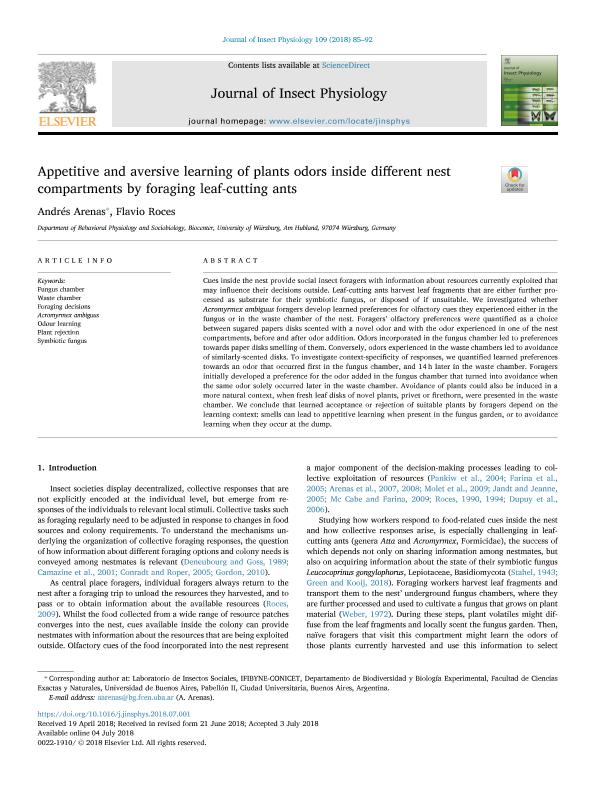Mostrar el registro sencillo del ítem
dc.contributor.author
Arenas, Andres

dc.contributor.author
Roces, Flavio

dc.date.available
2019-11-11T18:16:51Z
dc.date.issued
2018-08
dc.identifier.citation
Arenas, Andres; Roces, Flavio; Appetitive and aversive learning of plants odors inside different nest compartments by foraging leaf-cutting ants; Pergamon-Elsevier Science Ltd; Journal of Insect Physiology; 109; 8-2018; 85-92
dc.identifier.issn
0022-1910
dc.identifier.uri
http://hdl.handle.net/11336/88498
dc.description.abstract
Cues inside the nest provide social insect foragers with information about resources currently exploited that may influence their decisions outside. Leaf-cutting ants harvest leaf fragments that are either further processed as substrate for their symbiotic fungus, or disposed of if unsuitable. We investigated whether Acromyrmex ambiguus foragers develop learned preferences for olfactory cues they experienced either in the fungus or in the waste chamber of the nest. Foragers’ olfactory preferences were quantified as a choice between sugared papers disks scented with a novel odor and with the odor experienced in one of the nest compartments, before and after odor addition. Odors incorporated in the fungus chamber led to preferences towards paper disks smelling of them. Conversely, odors experienced in the waste chambers led to avoidance of similarly-scented disks. To investigate context-specificity of responses, we quantified learned preferences towards an odor that occurred first in the fungus chamber, and 14 h later in the waste chamber. Foragers initially developed a preference for the odor added in the fungus chamber that turned into avoidance when the same odor solely occurred later in the waste chamber. Avoidance of plants could also be induced in a more natural context, when fresh leaf disks of novel plants, privet or firethorn, were presented in the waste chamber. We conclude that learned acceptance or rejection of suitable plants by foragers depend on the learning context: smells can lead to appetitive learning when present in the fungus garden, or to avoidance learning when they occur at the dump.
dc.format
application/pdf
dc.language.iso
eng
dc.publisher
Pergamon-Elsevier Science Ltd

dc.rights
info:eu-repo/semantics/openAccess
dc.rights.uri
https://creativecommons.org/licenses/by-nc-sa/2.5/ar/
dc.subject
ACROMYRMEX AMBIGUUS
dc.subject
FORAGING DECISIONS
dc.subject
FUNGUS CHAMBER
dc.subject
ODOUR LEARNING
dc.subject
PLANT REJECTION
dc.subject
SYMBIOTIC FUNGUS
dc.subject
WASTE CHAMBER
dc.subject.classification
Zoología, Ornitología, Entomología, Etología

dc.subject.classification
Ciencias Biológicas

dc.subject.classification
CIENCIAS NATURALES Y EXACTAS

dc.title
Appetitive and aversive learning of plants odors inside different nest compartments by foraging leaf-cutting ants
dc.type
info:eu-repo/semantics/article
dc.type
info:ar-repo/semantics/artículo
dc.type
info:eu-repo/semantics/publishedVersion
dc.date.updated
2019-10-21T19:13:49Z
dc.journal.volume
109
dc.journal.pagination
85-92
dc.journal.pais
Países Bajos

dc.journal.ciudad
Amsterdam
dc.description.fil
Fil: Arenas, Andres. Universität Würzburg; Alemania. Consejo Nacional de Investigaciones Científicas y Técnicas. Oficina de Coordinación Administrativa Ciudad Universitaria. Instituto de Fisiología, Biología Molecular y Neurociencias. Universidad de Buenos Aires. Facultad de Ciencias Exactas y Naturales. Instituto de Fisiología, Biología Molecular y Neurociencias; Argentina
dc.description.fil
Fil: Roces, Flavio. Universität Würzburg; Alemania
dc.journal.title
Journal of Insect Physiology

dc.relation.alternativeid
info:eu-repo/semantics/altIdentifier/doi/http://dx.doi.org/10.1016/j.jinsphys.2018.07.001
dc.relation.alternativeid
info:eu-repo/semantics/altIdentifier/url/https://www.sciencedirect.com/science/article/pii/S0022191018301422
Archivos asociados
